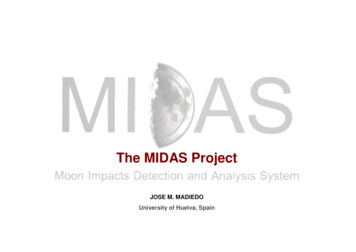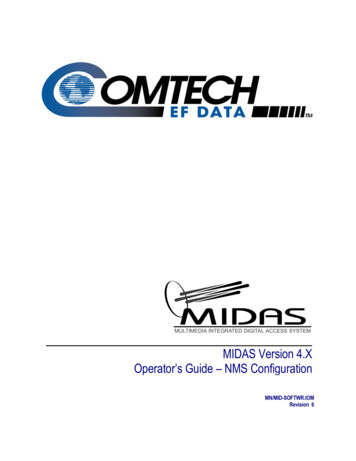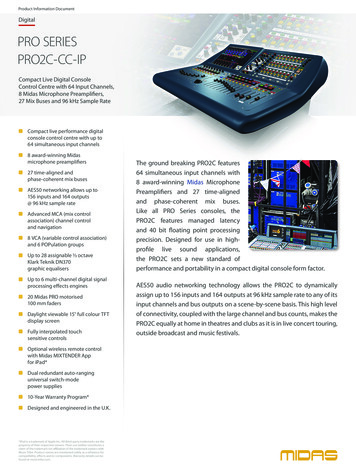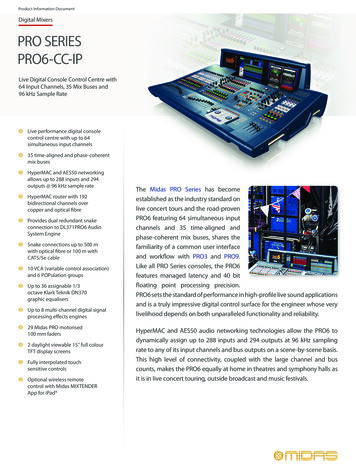
Transcription
The MIDAS ProjectJOSE M. MADIEDOUniversity of Huelva, Spain
OutlineDescription of the projectThe Moon Impacts Detection and Analysis System (MIDAS)Software toolsThe Impact flash detection and analysis software
Project descriptionINSTITUTIONS INVOLVEDUniversity of Huelva (UHU)Institute of Astrophysics of Andalusia,Spanish National Research Council (IAA-CSIC)AIMContinue previous work started by Dr. Ortiz et al. (IAA-CSIC)in 1999Systematic monitoring of the night size of the Moon
Project descriptionSCIENCEFocus on the analysis of parameters of interest for theoretical impact models:Luminous efficiencyCrater size and locationImpactor massImpactor fluxImpactor sourceTECHNIQUESMonitoring of the night side of the Moon with small telescopesInput (synergy) from meteor observing stations operated by UHU and IAA-CSIC
Where?OBSERVATORIESSevilla (in operation since 2009)La Hita (in operation since 2013)La Sagra (testing phase)
Main equipmentSevillaTwo 14" Schmidt-Cassegrain telescopesTwo 11" Schmidt-Cassegrain telescopesOne 9.25 Schmidt-Cassegrain telescopeHigh sensitivity CCD video cameras(Watec 902H Ultimate)MIDAS-IR (monitoring in the infrared)Two 11" Schmidt-Cassegrain telescopes
Main equipmentLa Hita Astronomical Observatory (remotely operated)One 16" Schmidt-Newtonian telescopeHigh sensitivity video camera(Watec 902H Ultimate)
Main equipmentLa Sagra (Startup planned for September 2015)Four 14" Schmidt-Cassegrain telescopesHigh sensitivity CCD video camerasPhase 1: operation "in situ"Phase 2: remote operation2nd node for MIDAS-IR
ProcedureMonitor the dark side of the Moon with at least two telescopesLimitations:Illuminated area must be, at most, about 50-60%Avoid terminatorObserving period: about 2 weeks per monthNew Moon-First QuarterLast quarter-New MoonHigh sensitivity CCD video camerasFocal reducers are employedEarthshine allows identifyingfeatures on the lunar surface
ProcedureMonitor the dark side of the Moon with at least two telescopesLimitations:Illuminated area must be, at most, about 50-60%Avoid terminatorObserving period: about 2 weeks per monthNew Moon-First QuarterLast quarter-New MoonHigh sensitivity CCD video camerasFocal reducers are employedEarthshine allows identifyingfeatures on the lunar surface
Input from meteor stationsCONTRIBUTION FROM METEOR STATIONSAnalyze the behavior of meteoroids in the atmosphereFact: meteoroid streams impacting Earth also impact the Moon(both bodies share a common meteoroid environment)Important to determine the source of meteoroids impacting the MoonSynergy with lunar impact monitoring
Input from meteor stationsMETEOR STATIONS OPERATED BY UNIVERSITY OF HUELVA10 meteor stationsFully automated systems50 CCD camerasCover about 95% of theIberian Peninsula andneighboring areasCollaboration with 15 extrastations operated by theSpanish Meteor Network
Software developmentMAIN REASONS TO DEVELOP SOFTWAREMost impact flashes are dim and last a fraction of a secondA large amount of video streaming is generatedImpact flash confirmation requires simultaneous detection from at least two systemsFlash identification with human eye is not practical
MIDAS: Moon Impacts Detection and Analysis SoftwareMoon impact flashes detection software. Developed by J.M. Madiedo.
MIDAS: Moon Impacts Detection and Analysis SoftwareDeveloped under C/C MS-Windows platforms (XP, Vista, 7, 8)Easily portable to other platforms (maybe in future)Requirements for specific or special features:Intranet connectionInternet connectionFast real time processing: up to 100 fps with 720x576 pixelswith Pentium 4 PC 2.4 GHz (depending on detection algorithm)
MIDAS: Moon Impacts Detection and Analysis SoftwareMain featuresImage capture (analogue and digital cameras)Image and video processingMoon Impact flashes identificationMethod 1: on the flyMethod 2: on previously recorded video streaming (preferred method)Very fast data reductionMoon impact flashes confirmationPhotometryCalculation of impact parametersDetermination of impactor sourceAdapted to indentify impacts on other bodies in the Solar System
Impact flashesdetectionImpactflash identification
Mask editor
Mask editorScintillation mask for stars and for Moon’s border isautomatically calculated by the software
MIDAS: Moon Impacts Detection and Analysis SoftwareImage and video processing kernelsVideo files must be processed before the flashes identificationWatec cameras generate interlaced videoImprove the detectability of fainter flashesMain processing routinesVideo deinterlacingNoise reduction filtersIncrease data reduction time
Inpact flash confirmation on the flyWhen a telescope detects an event, it communicates with other telescopes in thesystem via TCP/IP network protocolThe other telescopes may then confirm or not the detected eventIf the event is confirmed, it is automatically stored in a databaseIf event is not confirmed, it will be ignored (but recorded for manual inspection ifnecessary)Intranet and/or Internet connections are requested to use this featureSelenographic or X,Y coordinates are provided for impact flashesMethod 1: Previous calibration of the lunar diskMethod 2: Superposition of a lunar map
Inpact flash identification from previously recorded videoA database with potential impact flashes is generatedAfter the identification process is finished, the events database may be automaticallyemailed to the desired recipientsDatabases from different sources can be automatically compared by the software inorder to search for common events
MIDAS: Moon Impacts Detection and Analysis SoftwareData analysis kernelImpactor sourcePhotometryImpactor kinetic energyImpactor massCrater sizeLuminous efficiencyOther parameters
Impactor source identificationMeteoroid stream database (IAU Meteor Data Center)Aim: to check for compatible impact geometry
Impactor source identificationMeteoroid stream database (IAU Meteor Data Center)Aim: to check for compatible impact geometry
Impactor source identification
Impactor source identification
Impactor source identification
Impactor source identification
Impactor source identificationAn impact flash is associated to a given meteoroid stream ifThe impact geometry is compatibleThe event takes place during or next to the activity period of the correspondingmeteor showerIf the conditions above are not fulfilled, the impact is associated to the sporadicbackground.ProblemsThis "classical" procedure does not quantify the linkCan provide wrong resultsSolutionMIDAS employs a new method to quantify the link betweenan impact flash and ameteoroid source
MIDAS: Moon Impacts Detection and Analysis SoftwareADDITIONAL TOOLSTesting toolsMonitoring planning tools
Testing toolsIMPACT FLASH SIMULATORInserts a simulated flash on real footageUseful to.Optimize impact flash identification parameters (noisy images, IR, etc.)Know the limitations of a given experimental setup
Planning tools: Moon Phase Calendar
Planning tools: which area should be monitored?
MIDAS ProjectCurrent statusSystematic monitoring of impact flashesV-bandIR bandSetting up of new facilities at La Sagra Astronomical ObservatoryNew version of the MIDAS softwareAnalysis of data recorded before 2009Preparation of new publications
Future software developmentsSoftware tool to establish the source of meteoroids impacting the lunar surface- Web-based tool?- Open for the impact flash monitoring community- Joint project with additional partners?
ConclusionsWe have set up a system to monitor lunar impact flashes in SpainTwo stations in operationMonitoring in V and IR bandsWe are setting up another system in Southwest Spain (La Sagra AstronomicalObservatory)Four 14" telescopesMonitoring in V and IR bandsBetween 300 and 250 clear nights/year favor the observing tasksSoftware has been developed to identify and analyze impact flashes.Method to analyze the source of meteoroids impacting the MoonImportant synergy with meteor observing stations
Thank you!
Meteoroid stream database (IAU Meteor Data Center) Aim: to check for compatible impact geometry . The event takes place during or next to the activity period of the corresponding meteor shower If the conditions above are not fulfilled, the impact is associated to the sporadic . Monitoring planning tools MIDAS: Moon Impacts Detection and .









